When contractors and construction site workers need power for their tools on the job site and plugging into utilities is not an option, the most convenient solution is the generator. A generator can also be a life-saving device for the average homeowner, such as during a power outage (blackout) or disruption of utilities (brownout), or for DIYers looking for a workshop power source. Learn everything you need to know about the different types and sizes of generators, how to recognize which model best suits your needs, and how to use your generator safely.
Generator Basics
The purpose of a generator is to convert a supply of fuel into electric energy. This can provide power to an external circuit to plug in various power tools and appliances, from power drills to electric concrete saws. Depending on their type and design, generators can produce power through different methods and fuel sources, such as fuel-powered engines or solar panels. Some generators are manually activated, while others can detect if the power utilities are down, turning on automatically to maintain a constant power flow.
The Different Types of Generators
There are four categories of generators: standard portable generators, portable power stations, inverter generators, and standby generators. Each type serves a different purpose and features models of various sizes, designs, and fuel sources.
SHOP ALL OF OUR CONTRACTOR SUPPLIES
1. Portable Generators
Standard portable generators are the most common type of generator available on the market.
A portable generator typically consists of an internal combustion engine, an alternator, a starter, a fuel reserve, an exhaust, and an array of outlets. Portable generators must be manually started and shut off and require manual refueling. A portable generator produces power using an alternator, converting the engine’s mechanical energy into electrical energy. The engine’s size and power determine the amount of electrical energy a portable generator can produce.
The engines fitted in portable generators come in various sizes. For low-capacity tools, a small, single-cylinder, gasoline-powered model similar to those found in lawnmowers (ranging from 5 to 10 horsepower) is ideal. Large, multi-cylinder generators resembling small car engines (20 hp or more) are necessary for bigger projects. Like any other internal combustion engine, the engine in a portable generator requires fuel to operate. The most common fuel type is gasoline, although some models require alternative fuels, such as diesel, propane, or natural gas.
The Wacker GP 6600A Premium Portable Generator is a high-performance unit designed for heavy-duty construction site applications. The full wrap-around frame features dual cross-member supports and heavy-duty shock mounting to protect the motor and polyethylene fuel tank. It comes with a full 120V power switch producing a maximum 120V or 120V/240V of power, suitable for running construction equipment. This generator meets all current OSHA safety standards due to a unique GFCI (neutral bonded to ground) sensor system that prevents common outlet failures.
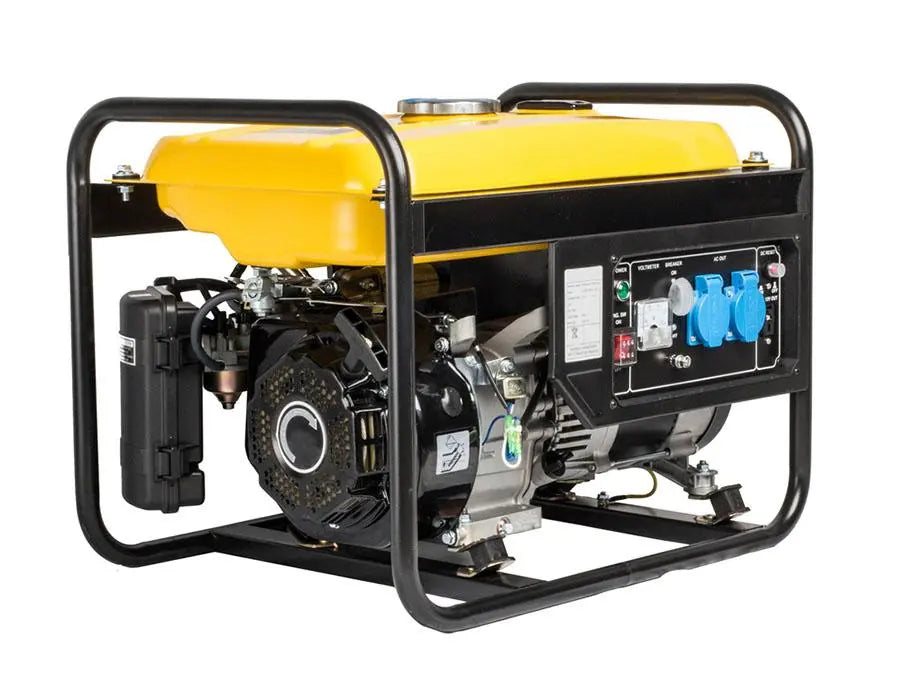
- Portable vs. mobile generators
Smaller portable generators are compact, usually 20-25" long, 20-25" tall, and 15-20" wide. They typically weigh around 100 to 125 lbs., making them challenging to lift. Some models may be compatible with generator wheel kits or lifting devices, making it easy to load and unload from the back of a truck. Due to their size and weight, contractors refer to larger models as mobile generators instead of portable generators. These models routinely weigh over 2,000 lbs. and come mounted on wheels and fitted with a towing trailer. The only way to move these generators in and out of position is to tow them with your car or truck, making them mobile (by vehicle) but not portable (by hand).
2. Inverter Generators
Although an inverter generator may seem similar to a standard portable generator at first glance, the electric power distributed by an inverter is slightly different. It is critical to understand how standard generators can produce power of varying quality on a job site. You also need to know why that quality matters when operating various equipment types.
- THD: A measurement of power quality
In a standard generator, the alternator essentially converts the engine’s mechanical power into electrical power directly, feeding the electricity straight to the outlets. While it makes such generators mechanically simple, it also means the power they produce has a certain amount of total harmonic distortion (THD).
The more distortion in a power supply, the more it stresses electrical circuits. This can cause damage to sensitive electronics, such as computers, smartphones, tablets, laptops, and video game consoles. The higher the THD percentage, the dirtier the power generated. This is somewhat like using low octane gasoline in an engine requiring high octane fuel. On average, a typical portable generator produces 10% to 20% THD. If it produces 6% or less, it is considered clean power and safe to use with sensitive electronics.
- How inverter generators differ from standard generators
An inverter generator has two additional parts: a rectifier and an inverter. Unlike a standard generator, the electrical energy produced by an inverter generator’s alternator does not directly reach the outlets. Instead, it first circulates through the rectifier. Here the power is converted from alternating current (AC) to direct current (DC).
The converted DC power then passes through the inverter, after which the generator is named, which re-converts the DC power back into AC before reaching the outlets. The AC power produced this way is much cleaner—usually no more than 1% THD. Inverter generators are smaller, easier to transport, quieter, cleaner, and more fuel-efficient than standard generators. However, they are typically more expensive, produce less power, and support fewer appliances.
The EcoFlow DELTA Portable Power Station combines the capabilities of an inverter generator with the convenience of a standard power station, providing you with reliable, clean power for all your tools and appliances. The Delta’s inverter supports equipment demanding up to 1800W of power (with a 3300W surge) and can be charged from 0 to 80% in less than an hour.
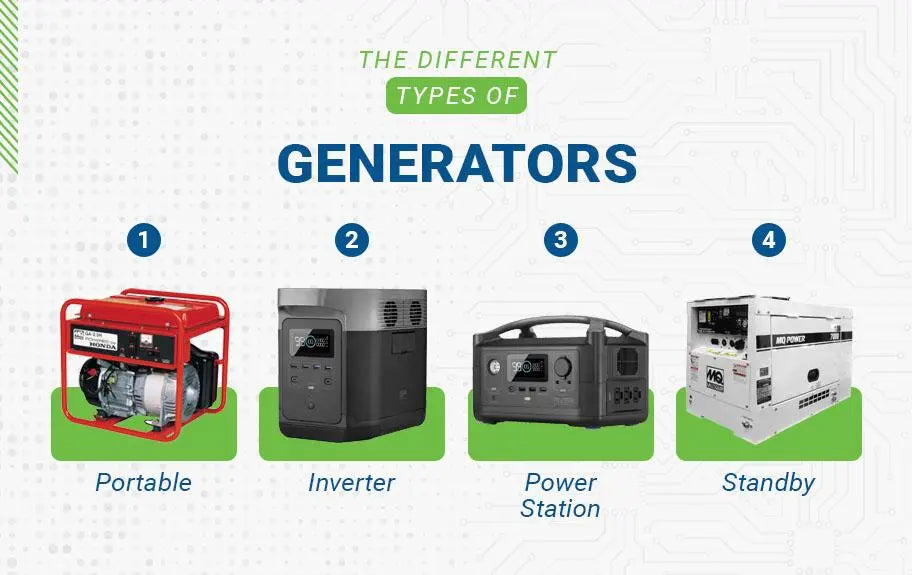
3. Portable Power Stations
Although a power station is similar to a portable generator in size and purpose, it functions differently from other generator types. Unlike a standard generator, a power station doesn’t come with an engine or a power plant of any kind. Instead, it functions more like a battery; it can hold a specific quantity of electrical energy, which it distributes via outlets, allowing it to power various tools and devices.
Like a battery, a power station requires recharging, either by plugging it into utilities, at an electric vehicle charging station, or with a car battery charger. Alternatively, you can turn a power station into a solar-powered generator by connecting it to a solar panel array. Some power stations can also function as inverters, providing clean, low-THD electricity. Although portable power stations typically cannot power as many devices as a standard generator, they offer numerous advantages. They are generally much lighter and easier to transport (30 to 50 lbs.). They also do not require flammable fuels to operate and do not generate harmful emissions. This feature makes power stations 100% safe to use indoors, allowing you to power your tools at an indoor job site even if utilities or extension cords are unavailable.
The EcoFlow DELTA Max Portable Power Station is the ideal renewable energy solution to power your home during an outage. A single Delta Max unit offers a 2kWh capacity and connects to EcoFlow solar panels to deliver 800W solar charging speeds. It comes with six outlets, and you can control and monitor its performance remotely using the EcoFlow app on your smartphone.
4. Standby Generators
A standby generator, also known as a backup generator, is a sizable, non-mobile power generation system designed to fulfill two purposes: provide enough power for a home or facility, and activate automatically if the power grid is down. Standby generators produce low-THD electricity (2% or less), making them safe for sensitive electronics. Standby generators are large and heavy, requiring a concrete foundation in a dedicated area of the property. They possess a unique part called an automatic transfer switch (ATS), which detects the power levels on the grid.
If there is a power outage in your area, the ATS automatically disconnects all connected devices and appliances from the mains, switching them to the generator. The ATS then starts the engine, producing electricity and providing power to your house like a standard generator. When the power outage ends, the ATS powers the engine down and reconnects the house to the power grid.
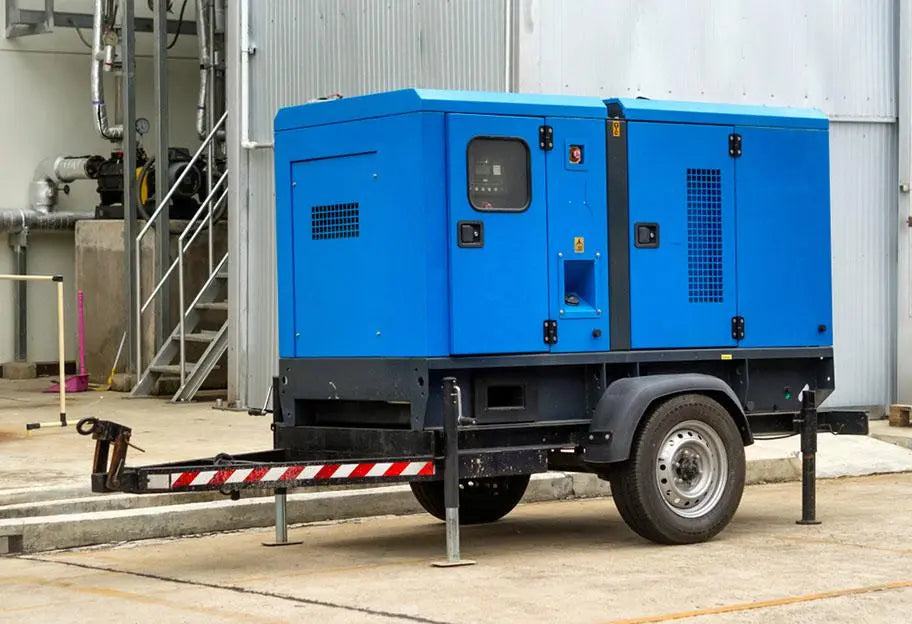
Standby generators have large, multi-cylinder engines, similar to small vehicle motors. A typical household standby generator features a two-cylinder, V-twin engine generating 25 to 50 hp. The most common fuel used by standby generators is diesel, although some may accept natural gas or propane. Natural gas standby generators can be connected directly to the gas mains instead of an independent fuel tank, allowing the standby generator to remain fueled indefinitely. However, this only works as long as gas utilities still function during the outage.
The Multiquip WhisperWatt Diesel Generator is one of the lightest and quietest standby generators on the market, weighing only 534 lbs. This single-phase generator is equipped with a Kubota 12.5bhp engine and a 6.6 gal. fuel tank. It can provide up to 7000W of 120/240V, low-THD electricity, more than enough to power a full suite of home appliances. Even when running at full load, the WhisperWatt remains quiet, producing only 65 dB.
Shop Our Selection of Generators
How to Choose the Right Generator
The primary criteria to consider when selecting a generator is the power output, measured in watts (W), sometimes kilowatts (kW), with 1kW equaling 1000W. You must choose a generator that provides the right amount of power. It must be large enough to power all the tools and equipment you’ll need and small enough to carry or transport to the job site efficiently.
If you choose a generator too small for your applications, you risk stressing or overheating the parts, severely reducing the generator’s lifespan. If it cannot produce enough power for all of your equipment, you may also risk damaging your equipment. Choosing a generator too large for your needs may introduce unnecessary operational expenses and complications. These can include inefficient fuel consumption or difficulties installing the generator in a suitable area.
To calculate your power requirements, add together the full load or maximum wattage of every tool you intend to plug into your generator, and then add 10% as a safety buffer. The result is the minimum wattage your generator should provide.
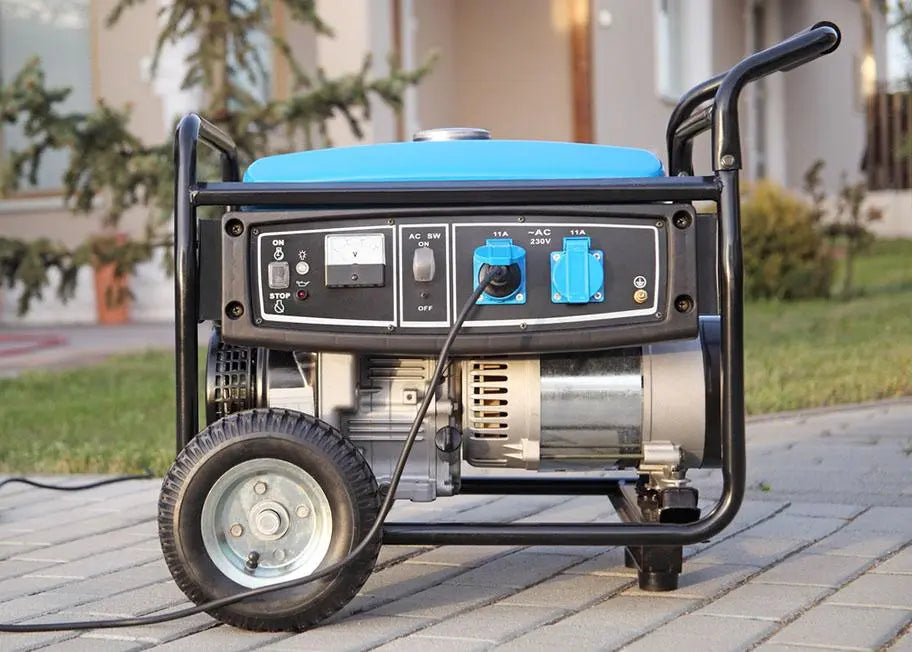
Tool and appliance wattage chart
The following is a list of wattage requirements for the most common contracting power tools. Remember that these are only examples and estimates to give you an idea of what to expect. Please refer to your tools’ specific values listed on the device or in the instruction manual.
- Angle grinder: 900-1800W
- Concrete floor grinder: 2200-4400W
- Concrete vibrator: 1200-1800W
- Core drill: 800-1300W
- Power cutter: 1200-2400W
- Power drill: 700-1800W
- Rail saw: 1500-2000W
- Rebar cutter: 1000-1500W
- Wet/dry vacuum cleaner: 1400-1600W
- Wet tile saw: 400-600W
The wattage requirements for common household appliances include:
- Ceiling fan: 30-90W
- Coffee maker: 750-1,500W
- Dishwasher: 1,200-2,200W
- LED lightbulb: 1-10W
- Microwave: 900-1500W
- Refrigerator: 500-800W
- Television: 100-300W
For example, if you need a generator on a job site where you expect to use a 1500W angle grinder, a 500W wet tile saw, and a 2000W power cutter, here is the formula you need:
- (1500 + 500 + 2000) ✕ 1.1 = 4000 ✕ 1.1 = 4400
- Your generator must be able to produce a minimum of 4400W to keep these tools safe and simultaneously powered.
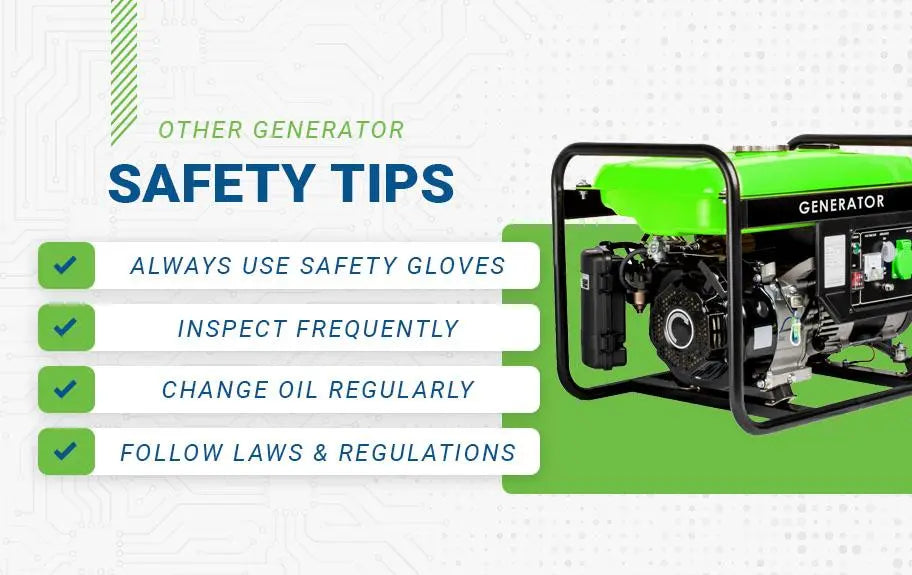
Generator Safety and Maintenance
When using a generator, you must follow specific safety rules and maintenance routines. Failure to use a generator safely can create multiple types of hazards. There are several common safety and maintenance guidelines you should follow.
Power safety
Do not, under any circumstances, plug the generator into a wall outlet or an electrical panel. You risk back-feeding the generator’s power into the power lines, creating a severe fire and electrical hazard. Always ensure that no equipment is plugged into the generator when starting or stopping, and always use high-quality power cords in good condition. If one of your cords is damaged or has exposed wires, discontinue usage immediately and replace it.
Exhaust and ventilation safety
Unless you’re using a 100% indoor-safe power station that produces no exhaust, you should never use your generator indoors. Always place your generator outside, in a well-ventilated area at least 15 to 20 feet away from the job site. Exhaust fumes generated by a typical gas-powered generator can produce lethal carbon monoxide (CO) levels in the air within minutes, potentially resulting in severe health complications or death.
Moisture safety
Generators are sensitive to moisture, and touching a wet generator creates a risk of electrocution. Always keep your generator dry and avoid operating it in humid conditions. If you need to use your generator in inclement weather, protect it from the elements with a purpose-built safety canopy.
Fuel safety
Always maintain an adequate fuel supply for your generator, and do not let it run out of gas. If you completely deplete your generator’s fuel supply, you risk causing damage to some of its internal components, such as the demagnetized coils. Always empty your generator’s fuel tank when not in use. Allowing fuel to stagnate inside your generator can create harmful deposits called gum, which can reduce your generator’s engine performance, damage internal parts, or cause failures to start.
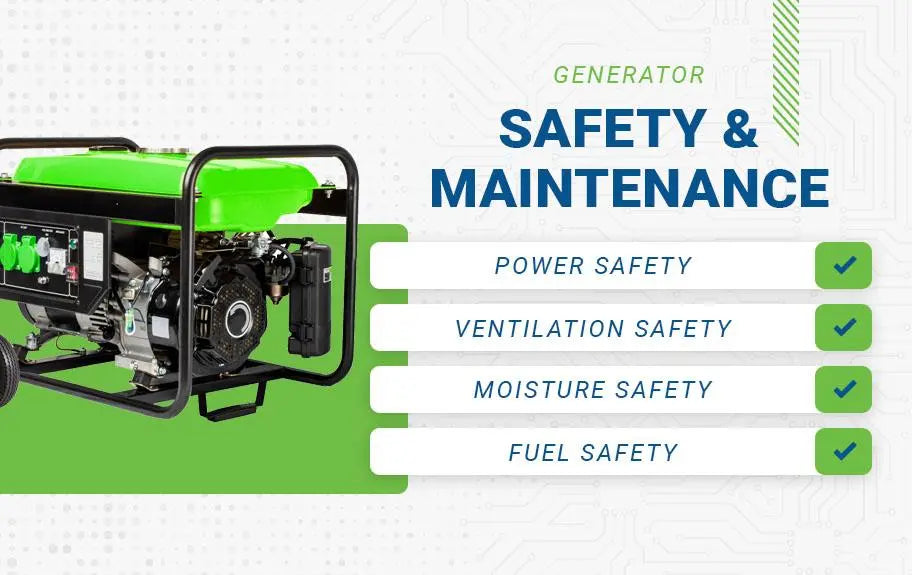
Other safety and maintenance tips
- Always use safety gloves near a generator, and avoid touching a running generator; some parts may be hot enough to cause burns.
- Inspect your generator frequently, primarily if you use it several times per month. Clean the generator often and check the pipes and valves for cracks, leaks, or signs of damage.
- Like car engines, generators require regular oil changes to operate reliably. Oil change requirements vary significantly depending on the generator’s size, ranging from 50 hours for small portable generators to 500 hours on large diesel standby models.
- Follow all applicable laws and regulations regarding generator usage, operation, and fuel storage.
Power Your Tools with Generators from Contractors Direct
At Contractors Direct, our mission is to provide professional contractors and DIYers with premium-quality products for the best prices. We have over 25 years of experience supplying industry professionals with top-quality generators suitable for powering a wide range of tile, stone, concrete, and masonry tools.
Image Credits
Tartila/Shutterstock.com
ArtHead/Shutterstock.com
Visionsi/Shutterstock.com
FARBAI/Shutterstock.com
MAXSHOT.PL/Shutterstock.com
ShutterBestStudio/Shutterstock.com
canoniroff/Shutterstock.com

